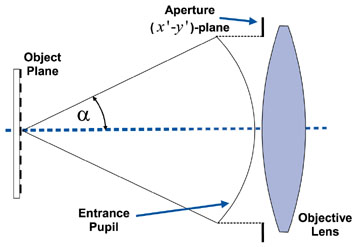Optipedia • SPIE Press books opened for your reference.
The Numerical Aperture
Excerpt from Field Guide to Optical Lithography
Light passing through the mask (the object plane) is diffracted at various angles. Given a lens of a certain size placed at a certain distance from the mask, there is some maximum angle of diffraction α for which the diffracted light just makes it into the lens. Light emerging from the mask at larger angles misses the lens and is not used in forming the image. The most convenient way to describe the size of the lens aperture is by its numerical aperture, defined as the sine of the maximum half-angle of diffracted light that can enter the lens times the index of refraction of the surrounding medium: NA = n sinα.

A large numerical aperture means that a larger portion of the diffraction pattern is captured by the objective lens. For a small numerical aperture, much more of the diffracted light is lost. The diffraction pattern for a repeating mask pattern is a series of discrete diffraction orders. The numerical aperture controls the number of diffraction orders that are used to form the image, and thus the quality of the image. For a lens with magnification, there is an object side and an image side numerical aperture, and the ratio of the two is the magnification factor.
C. A. Mack, Field Guide to Optical Lithography, SPIE Press, Bellingham, WA (2006).
View SPIE terms of use.

